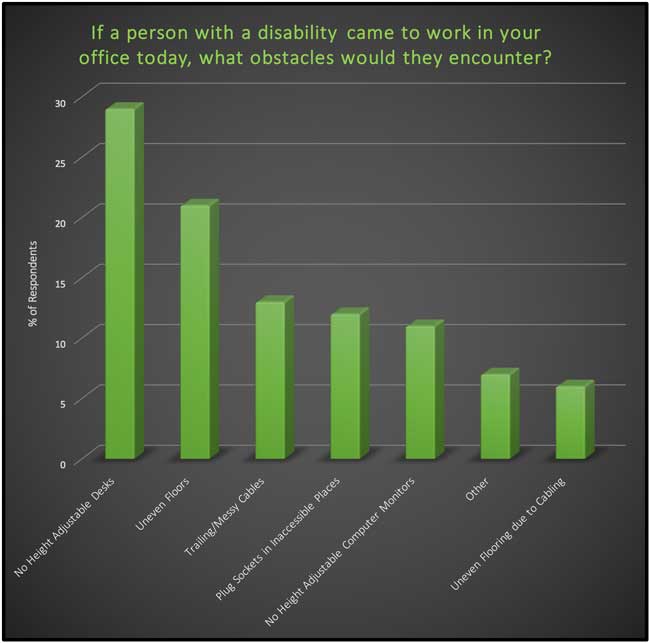« Back to Facilities Management ADA Category Home
Technology Can Help Build an Inclusive Workplace
June 7, 2017
- ADA
By Bruce Cantrill
Creating a work environment to suit the needs of all employees can be a challenge, especially when working to a budget. A one-size-fits-all approach is often the solution, which clearly doesn’t take into consideration the additional needs of employees with disabilities.
But it is easier than you may think to integrate the needs of employees with restricted movement into the every-day office set up.
To determine the shortfalls that employees with disabilities experience in day-to-day office life, we carried out a survey in partnership with Shaw Trust, the United Kingdom national charity that helps employees with disabilities find employment. The question: Could an employee with disabilities start work in your office right now?
The survey, amongst 515 18-64 year olds, revealed that workers didn’t feel that an employee with disabilities could start work in their workplace without any adjustments being made to the office set up. The “red flag” areas highlighted in the survey were non-adjustable desks, uneven floors, trailing cables, and plug sockets in inaccessible places.
Of course some countries have basic legal requirements which must be adhered to in terms of providing accessibility for employees with disabilities, such as accessible entrances, toilets, and parking; however, other practicalities, such as the above “red flags” are rarely taken into consideration. Although it is clearly unacceptable that employees with disabilities aren’t fully catered for as a basic requirement in many offices, the good news is, these results suggest that the problem areas can easily be rectified.
Common Sense Aided by Technology
In the grand scheme of office fit outs, employees with disabilities are often expected to adapt standard work stations to suit any additional needs that they may have. This is usually because of the perception that specialist furniture will be expensive and even ugly within a design conscious space.
The truth, however, is that advances in office ergonomics mean that desks, monitor arms, and even power modules can be quickly and easily adjusted and positioned to suit any employee, no matter what their physical ability. No need for specialist furniture and certainly no need for any compromise on the office aesthetics.
Adaptability Equals Inclusivity
The key to creating an all-inclusive workplace is adaptability. This applies to all areas, from furniture selection to the mindset of those choosing it. Simple changes can make the world of a difference to an employee with restricted movement, and this doesn’t necessarily mean individuals who are registered as having a disability.
At any point in most working environments, there are likely to be certain employees who are experiencing restricted movement, whether this is a temporary condition such as a broken leg or the latter months of pregnancy or ongoing conditions such as back problems or age-related issues.
Interestingly, statistics from the Disability Business Forum show that 7 out of 10 people with disabilities become disabled during their working lives.
This fact alone further enforces the need for an inclusive workplace in order to retain existing staff who may become disabled, as well as attracting new employees.
The survey also revealed that older employees considered hard to reach plug sockets to be more of a problem than the younger people surveyed, again putting accessibility in the foreground in terms of employee wellbeing.
Flexible Working for All
Investment in adaptable working will also enhance the flexibility within an office, allowing disabled workers to hot desk and work with different team members in different areas of the office as projects require.
Aside from creating a positive working environment internally, increased inclusivity also resonates outside the office, as a forward thinking attitude not only works wonders for retaining staff and clients, it also makes a company much more attractive to new employees and customers.
Bruce Cantrill is head of marketing and new business at CMD, manufacturers of integrated power and ergonomic solutions for commercial spaces.









